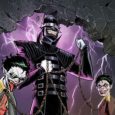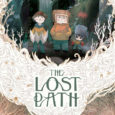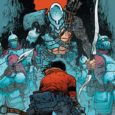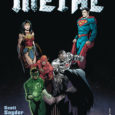After switching to its now bi-monthly release schedule, Doomsday Clock returned last week with Issue #4, which picks up straight after last issue’s cliffhanger ending and focuses on the origin of the mysterious new Rorschach. The story jumps between Rorschah’s previous stay in a mental asylum post-Watchmen and his current incarceration in Arkham Asylum.
Of the two plot lines to follow, the flashback story is the most intriguing. Following the newer Rorschach after the New York attack it’s revealed that not every person exposed to the “alien invasion” died instantly. Many suffered from horrific visions and are left severely traumatized. One of these victims is Reggie, a young man whom writer Geoff Johns wisely connects to the original Rorscach through his relationship to his father. Providing Reggie with an interesting perspective on a character most others consider to be a crazed vigilante.
Symmetry as a theme is present throughout this issue in both the art and writing, with Reggie’s confinement in both timelines mirroring one another and obligatory nods to Walter Kovac’s capture in the original Watchmen. Reggie’s decision to spare Ozymandias towards the end is an example of a man not beholden to the same strict code of his predecessor allowing the character to share many of the same traits but with an added element of unpredictability. Where the story diverges, however, is with the introduction of Mothman.
Mothman is used skillfully by Johns not only to provide a mentor for Reggie, but also as an explanation for how he was able to assume the persona of a new Rorschach and obtain the tools required to confront the man responsible for his parents death.
As a character, Mothman provides a warmth and humour in what would be an otherwise dreary setting. Mothman’s eventual fate is heartbreaking in it’s execution, as are his letters to an estranged sister, which serve as this issues epilogue. This is a character whose inclusion could verge too far towards fan service in another writers hands, but thankfully Johns allows the character to be an essential part of the narrative instead of a throwaway gag or lazy reference.
Another character who arrives in the final few pages is Saturn Girl, something of a reward for fans who have been reading DC Rebirth since its launch. Up until this point, Saturn Girl had only appeared in small cameos, hinting at a connection to the wider Doomsday Clock story. It’s nice to see threads like this finally begin to converge, even if her escape from Arkham could throw up more questions than it answers. The final page delivering an image guaranteed to leave readers discussing its symbolism and implications for the narrative going forward.
It is now a given to say that Gary Frank’s art continues to impress this issue. Mothmans late night flight is the obvious highlight and the overall pacing and detail of each page once again compliments Johns writing perfectly, demonstrating a symbiotic storytelling relationship similar to the one shared by Alan Moore and Dave Gibbons. Frank’s smaller details, such as the halls of Arkham resembling those in The Killing Joke, is a delightful example of these two creators weaving a DC universe intrinsically connected to Alan Moore’s previous work.
Doomsday Clock continues to be THE comic book event of the year. If Geoff Johns and Gary Frank continue this level of quality for the entire run, it’s sure to be considered a modern classic.











